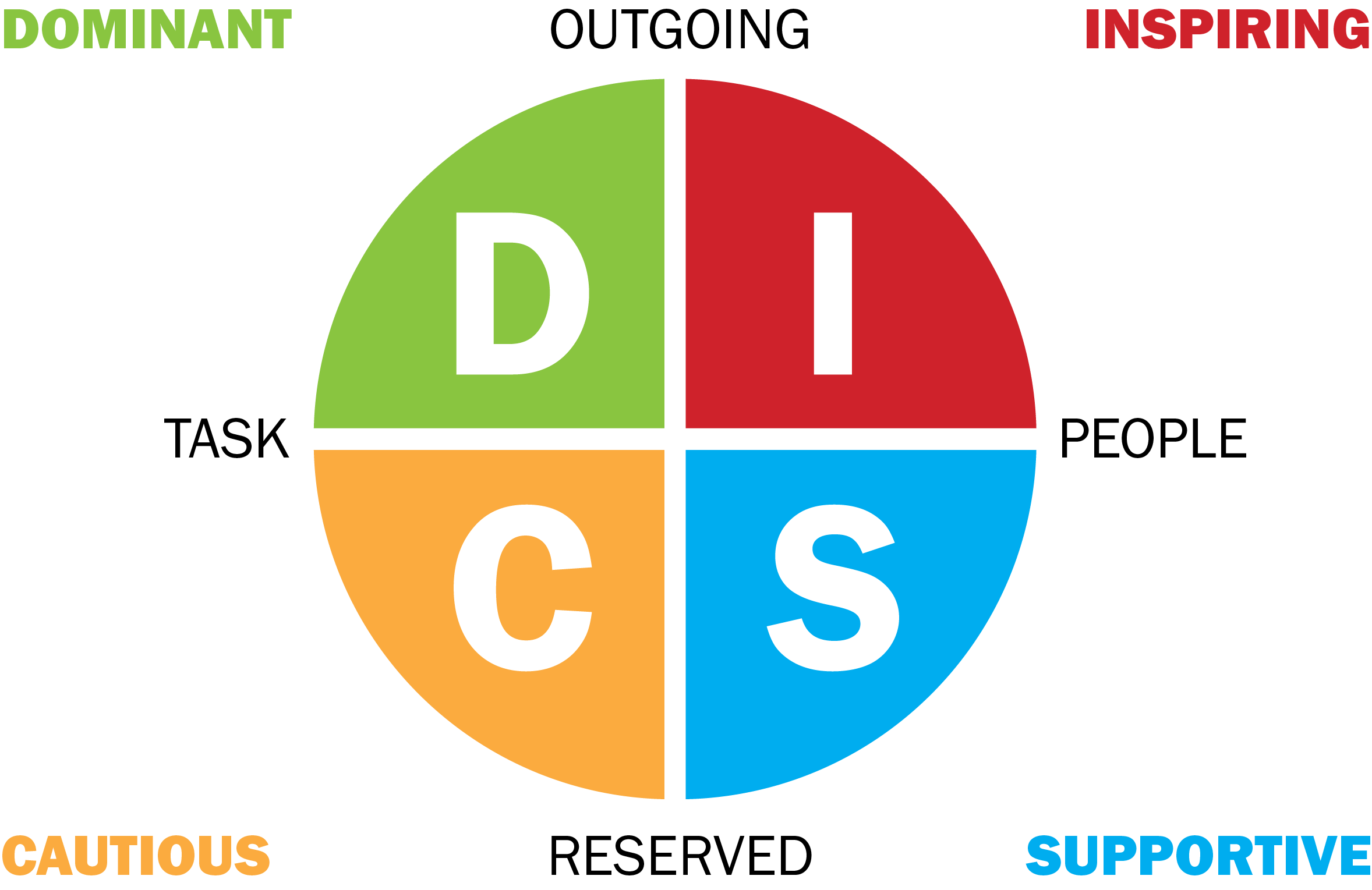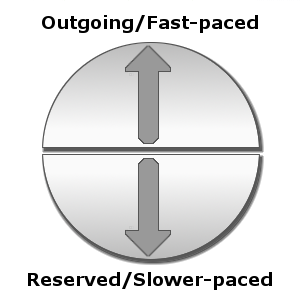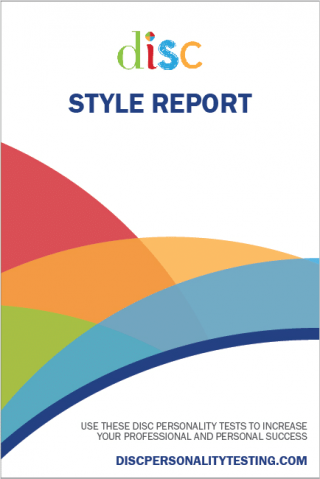What Is the DISC Model?
Introduction to the DISC Model of Human Behavior
The DISC Model is a popular tool for understanding how people act differently. Here’s the thing – most of us see the world from our own point of view. This makes it hard to understand how someone else might see things. The DISC model helps us bridge that gap so we can better understand why our reactions might be different from another person’s.
Because our reactions affect how we act, talk, and make choices, this deeper understanding can really improve how we communicate and work together—especially at work and in leadership roles.
Rather than labeling personality, the DISC Model looks at behavior you can see. It gives you a practical way to understand why people handle tasks, relationships, and challenges differently. It also shows how those differences affect communication and teamwork.
The model is based on the idea that our behaviors and communication styles can be put into different groups. These groups show how we naturally respond to our surroundings and to other people. These natural tendencies show up in how we make decisions, respond to others, handle projects, and what motivates us (or turns us off).
When people recognize and understand the different DISC styles, organizations and individuals can communicate better, have less conflict, and work together more effectively. One thing we like about the DISC model is that it’s simple. This makes it easy to use in many different places, from companies to personal relationships. It gives insights into natural tendencies without making negative judgments or putting labels on people.
The DISC Model gives you a way to understand yourself and others better. This promotes empathy, collaboration, and positive interactions in many situations.
What the DISC Model Measures (and What It Doesn’t)
What DISC Measures: Observable Behavioral Patterns
Even though terms like “personality” or “personality style” are often used with DISC, the model actually describes patterns of behavior, not personality traits. It also doesn’t address things like personal values, intelligence, work ethic, or mental health.
What DISC Does Not Measure
The DISC model doesn’t try to explain everything about a person. Instead, it gives you a useful way to understand behavioral tendencies that can be seen, talked about, and changed. The idea of using “objective observation” rather than “subjective judgment” makes DISC a valuable behavioral assessment tool.
The DISC Model does help answer questions like:
-
Why do some people decide quickly while others take more time?
-
Why do some people focus on results first, while others put relationships first?
-
Why do communication styles sometimes clash—even with good intentions?
-
Why do some people get energized by talking with people while others get exhausted by it?
The model identifies four main behavioral styles—Dominant, Inspiring, Supportive, and Cautious—that represent different patterns of behavior. These four styles are the foundation of the DISC model.
Understanding the DISC model supports personal growth and leadership development by highlighting natural tendencies. This allows you to adapt your communication style and work approaches to different interactions. Taking a DISC assessment gives you valuable insights that help you create positive results from your interactions and achieve greater success in many areas of life.
The Two Core Behavioral Drives Behind DISC
At the heart of the DISC Model are two separate behavioral drives. These drives exist on sliding scales, meaning people fall at different points depending on the situation. These drives help explain the wide variety of behaviors and communication styles people show in different situations.
Pace Drive: How Quickly People Act and Decide
Figure 2: Motor Drive
The first drive, often called the “pace drive,” shows how quickly a person tends to act, speak, and make decisions. This drive ranges from fast-paced, outgoing people who are more spontaneous and assertive, to slower-paced, reserved people who prefer to think things through carefully before responding.
Priority Drive: What People Focus On First
Figure 3: Compass Drive
The second drive, known as the “priority drive,” shows what a person tends to focus on first—tasks or people. Task-oriented people put results, efficiency, and logic first. People-oriented individuals focus on relationships, emotions, and connection.
Together, these two behavioral drives form the foundation of the DISC Model. They allow it to account for different personalities by combining pace and priority in various amounts and percentages. This dual-drive framework makes DISC a powerful tool for improving self-awareness, communication, and teamwork. It highlights not only what people do but helps you understand why they might have done it.
Pace Drive (How People Act)
The pace drive shows how quickly and outwardly a person tends to act, speak, and make decisions.
Faster-paced (Outgoing) individuals often:
-
Act and decide quickly
-
Express thoughts and emotions openly
Slower-paced (Reserved) individuals often:
-
Observe and analyze before responding
-
Express thoughts and emotions more privately
Neither pace is better or worse. These differences simply show how people tend to engage with their environment and process information.
Understanding pace differences helps reduce friction in communication by setting more realistic expectations around speed, urgency, and decision-making. For example, a faster-paced person may prefer quick decisions and immediate action, while a slower-paced person might favor thoughtful analysis and careful planning.
Recognizing these natural variations can improve workplace culture by building respect for different work preferences. It also helps in conflict resolution by helping team members appreciate why others may respond differently to deadlines or changes.
Priority Drive (What People Focus On)
The priority drive shows what a person tends to focus on first when thinking or deciding.
-
Task-oriented individuals often focus on results, logic, and efficiency.
-
People-oriented individuals often focus on relationships, emotions, and connection.
Most people show elements of both orientations, depending on the situation.
Task-oriented people might put meeting deadlines, achieving goals, and solving problems first with a focus on facts and logic. They often like structured environments with clearly defined goals and responsibilities. People-oriented individuals tend to value connecting with others, cooperation, and good relationships within their teams. They’re often motivated by relational connection and recognition more than by task accomplishment alone.
Understanding the priority drive helps in resolving conflicts and improving team dynamics. When you recognize that some colleagues are driven by tasks and others by relationships, you can adapt your communication style accordingly. This awareness can help you see your task-oriented coworker more positively when you understand that their response isn’t necessarily driven by anger or frustration—it’s just a focus on accomplishing the task.
Understanding the priority drive also helps leaders better lead and delegate. Leaders who understand these different priorities can tailor their leadership approach to meet the needs of their team members, balancing the sometimes competing demands of achieving results while maintaining positive relationships with people.
How the Four DISC Styles Emerge

When the pace drive and priority drive are combined, they form the structure of the DISC Model. This structure results in four main behavioral styles:
-
Dominant (D) – Faster-paced and task-focused
-
Inspiring (I) – Faster-paced and people-focused
-
Supportive (S) – Slower-paced and people-focused
-
Cautious (C) – Slower-paced and task-focused
These styles are reference points, not boxes. They describe common patterns of behavior rather than rigid categories.
For a deeper explanation of each style, see our guide to the four DISC styles.
DISC Styles Are Not Fixed and Rigid
Understanding the Flexibility of DISC Styles
One common misunderstanding is that DISC assessments assign people a single, fixed type. In reality:
-
Everyone shows all four styles to some degree
-
Most people show a blend of two primary styles
-
Behavior can shift based on roles, environment, and pressure
Reports from a DISC assessment are best understood as a relative measure of DISC style blends rather than absolute measures against a fixed standard. This approach encourages viewing behaviors as flexible and context-dependent rather than as fixed traits.
By focusing on tendencies, DISC allows for a detailed understanding of human behavior. It helps us see patterns in our own actions and reactions, as well as those of others, so we can engage with empathy and understanding rather than criticism and judgment.
Our application of the DISC model emphasizes the value of blends of styles rather than putting people into a single category. Most people have a primary style but also have secondary traits that influence how they behave. This blend creates a unique profile for each person that has a core set of attributes that are pretty stable over time while still having nuance that can evolve with experience and changing circumstances.
Why DISC Is a Practical Tool
Benefits of Using DISC for Self-Awareness and Communication
DISC is most effective when used to:
-
Increase self-awareness
-
Improve communication
-
Understand differences in perspective
-
Adapt leadership and collaboration styles
It works best when approached with curiosity rather than judgment.
By increasing self-awareness, you gain clarity about your own behavioral tendencies. This enables you to recognize how your natural style influences your decisions, communication, and relationships. This awareness is the foundation for personal growth and more intentional interactions.
Improving Teamwork and Reducing Conflict with DISC
Understanding your own style alongside others’ helps reduce misunderstandings and creates more effective exchanges. For example, knowing that a colleague has a dominant style may encourage you to be more direct and brief, while recognizing a supportive style might prompt a more patient and empathetic approach.
DISC highlights that variations in behavior aren’t right or wrong but simply different ways people respond to situations. This mindset encourages respect for others’ viewpoints and reduces conflict by promoting empathy and open-mindedness.
Adapting Leadership and Collaboration Styles
Leaders can tailor their approach to fit the needs of their team members, whether that means providing clear direction for a dominant personality or offering reassurance and support to a steadier individual. This flexibility strengthens workplace culture and drives better organizational outcomes.
Approaching DISC with curiosity rather than judgment creates a safe space for exploration and learning. It invites you to see behavior as a dynamic spectrum rather than fixed labels.
A helpful rule of thumb is: Think in terms of tendencies and blends, not boxes and labels.
Summary
The DISC Model provides a simple, practical way to understand behavioral differences by examining how people tend to act and what they prioritize.
By recognizing that behavior is relative, situational, and adaptable, DISC helps individuals and teams communicate more effectively and work together with greater clarity and respect.




Are there any peer-reviewed scientific studies that validate this approach?
Hi Jurgen,
Thanks for asking.
Honestly, I don’t know. The model has been around since before I was born and the first assessment using the model was developed in the 1950’s. It’s been pretty well tested and evaluated, but I don’t know about peer-reviewed studies.
Since we don’t promote using the model for diagnostic or clinical applications, I’m not sure that it matters though. The model and the assessment have somewhere in the range of 90% face validity. For our purposes of finding practical ways of understanding and communicating with people who have different perspectives, face-validity testing is sufficient.
If we wanted to use the model for some type of clinical evaluation or psychological diagnosis, then peer-reviewed studies would definitely make sense. That’s just beyond the scope of how we promote and apply the information.